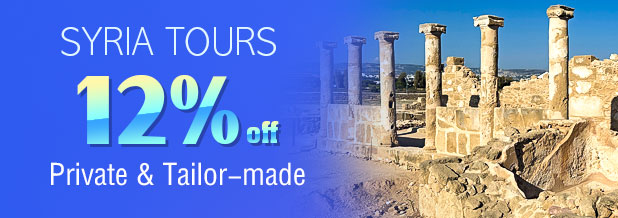Syria Travel Guide
Basic Facts of Syria
Location: Western Asia, Middle EastArea: 185,180 square meters (71,498 square miles)
Population: 18.43 million
Language: Arabic
Currency: Syrian pound (SYP)
Time Zone: EET (UTC+2)/Summer EEST (UTC+3)
Capital: Damascus
Administrative Division: 14 governorates
Religions and Beliefs: Sunni Islam
Top Things to Do in Syria
As a country with a long history and ancient civilization, Syria has a wealth of historical and cultural tourism resources. Many ancient civilization cities with long histories are worth a visit, such as Damascus and Aleppo. In the Syrian capital Damascus, the straight street, the famous Umayyad Grand Mosque and the Kisan Gate are the top three popular tourist attractions. There are also many mosques built in various historical periods in Damascus City. In Aleppo, the most famous tourist attraction is the Citadel of Aleppo, which is considered as one of the oldest and largest castle in the world. Travelling through these ancient cities, you can feel the imprint of history and the incredibility of human civilization.Best Time to Visit Syria
Syria has Mediterranean climate with rainy winter, dry summer and short spring and autumn. The climate in the country is relatively mild, with an average temperature of 32°C (90°F) in summer, 10°C (50°F) in winter, and 22°C (72°F) in spring and autumn.The best travel time is the warm spring from March to May. The fall from September to November is the second choice. The temperature began to increase gradually in June and it is the hottest in mid-September. Seaside areas such as Tripoli and Lattakia will be extremely sweltering and the inland areas will be relatively dry. At this time, visitors who like the sun can lie on the beaches of the Mediterranean Sea, but it is not suitable for exploring ancient relics. In particular, going northeast through the desert will be a great challenge. The best way to travel in summer is to go out in the early morning and evening, and rest in hotel in the afternoon. Winter rain is inconvenient for travel. However, snow can be seen in Damascus and high latitudes.
Transportation
Syria's transportation facilities are quite cheap, you can choose from buses, taxis, trains, and domestic flights, which are usually operated according to timetables. Trains are the preferred method of travel because there are a large number of trains connecting most cities. If you take a short trip from the hotel to market or neary tourist attractions, taxis are the best option for you - you can rent them for a day or take a short trip on your billing basis.
Air
There are several international airports in big cities such as Damascus and Aleppo. Domestic flights connect Damascus and major cities such as Aleppo, Qamishle, Lattakia and Deir ez-Zur.
Railway
The Syrian railway line is 2,790 kilometers (1,734 miles) long. The main route links Damascus, Aleppo, Deir ez-Zur, Hassake and Qamishle.
Highway
Syria has a developed road network between cities, which can also lead to adjacent countries such as Turkey, Iraq, Jordan and Lebanon. Public transportation is very convenient and relatively cheap.
Syria Travel Tips
Syria is an Islamic country. Travelers should respect Muslim customs, such as not eating pork, and not taking the initiative to shake hands with a woman. Like other Muslim countries in the Middle East, neither school holidays nor fasting months are suitable for travel. Visitors should check the time of Ramadan in advance since it is in different time each year.Because of the civil war started in 2011, many governments do NOT recommend their citizens to travel to Syria.
History
Syria is one of the oldest civilizations in the world. It had experienced Phoenician, Hittite, Mitani Kingdom, Assyrian, Babylonian, Ancient Egypt, Persian Empire, Macedonian Empire, and the following Roman Empire. Before 633, Syria was the birthplace and dissemination center of Christianity. After the expansion of the Arab Empire in the Middle East, from the 7th century to the beginning of the 16th century, it had been one of the centers for the spread of Islam. It became part of the Ottoman Empire by 1516. France invaded Syria in the 18th century and declared it a protected site. After the World War I, it was ruled by the French. In 1944, it declared independence from Vichy France, but foreign troops were stationed until the formal independence in 1946. From the beginning of 2011, a prolonged conflict between the Syrian government and the Syrian opposition has been going on.Geographical Features
Most of Syria’s territory is a plateau that is tilted from northwest to southeast. The country can be divided into four zones:1. The western mountainous region, including the highest peak of Sheikh Mountain in the southwest, 2,841 meters (8,140 feet) above sea level.
2. The northwestern Mediterranean coastal plain, with a coastline of 183 kilometers (114 miles), is one of the few green places in the country.
3. The eastern inland plateau.
4. The southeast Syrian desert.

